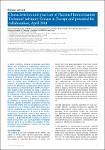Characteristics and practices of National Immunisation Technical Advisory Groups in Europe and potential for collaboration, April 2014
Takla, Anja
Wichmann, Ole
Carrillo-Santisteve, P.
Cotter, S.
Lévy-Bruhl, D.
Paradowska-Stankiewicz, I.
Valentiner-Branth, P.
D’Ancona, F.
Group, VENICE III NITAG Survey
In many countries, national vaccination recommendations are developed by independent expert committees, so-called national immunisation technical advisory groups (NITAG). Since the evaluation of vaccines is complex and resource-demanding, collaboration between NITAGs that evaluate the same vaccines could be beneficial. We conducted a cross-sectional survey among 30 European countries in February 2014, to explore basic characteristics and current practices of European NITAGs and identify potential modes and barriers for collaboration. Of 28 responding countries, 26 reported to have a NITAG or an equivalent expert group. Of these, 20 apply a systematic approach in the vaccine decision-making process, e.g. by considering criteria such as country-specific disease epidemiology, vaccine efficacy/effectiveness/safety, health economics, programme implementation/logistics or country-specific values/preferences. However, applied frameworks and extent of evidence review differ widely. The use of systematic reviews is required for 15 of 26 NITAGs, while results from transmission modelling and health economic evaluations are routinely considered by 18 and 20 of 26 NITAGs, respectively. Twenty-five countries saw potential for NITAG-collaboration, but most often named structural concerns, e.g. different NITAG structures or countries’ healthcare systems. Our survey gathered information that can serve as an inventory on European NITAGs, allowing further exploration of options and structures for NITAG collaboration.
Dateien zu dieser Publikation
Keine Lizenzangabe

